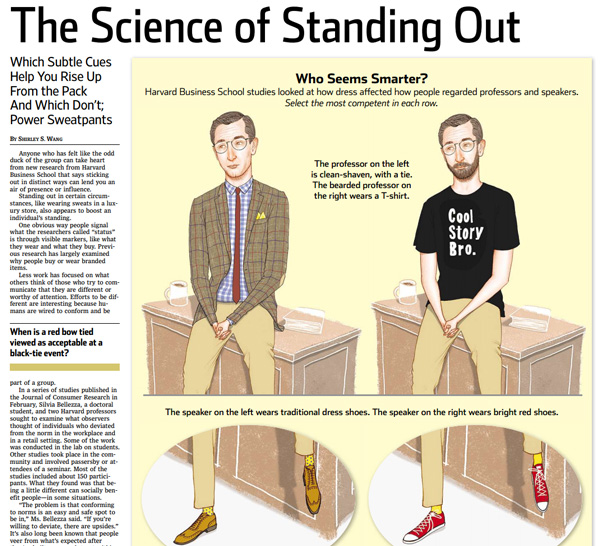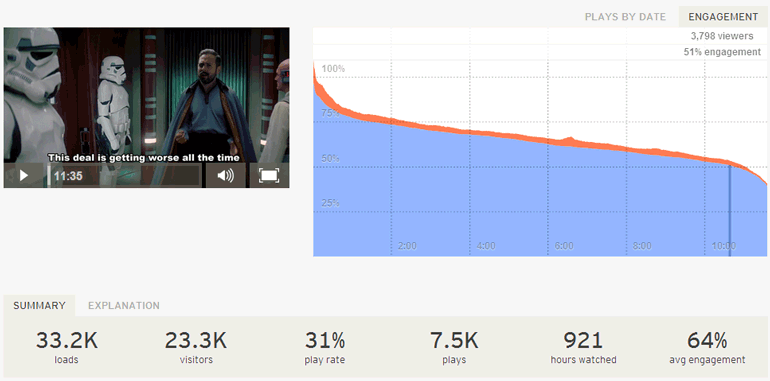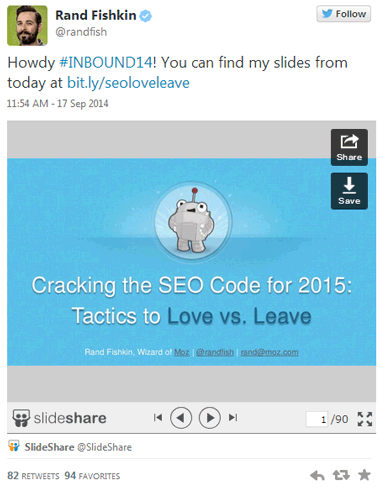I don’t particularly like the phrase “thought leader” or “thought leadership” for two reasons: 1) just *thinking* about something doesn’t make you a leader, nor does being a leader enable you to simply think about things AND 2) the term has pretentious and sometimes negative associations. When I hear people describe me that way, I have a viscerally uncomfortable reaction. I kinda wish the terminology would go away.
That said, at the recent Foundry CEO Summit, a number of the CEOs asked me to talk about and share my “secrets to becoming a thought leader” in the marketing space. They weren’t buttering me up (I don’t think) – they just wanted to understand how to build a more compelling, well-known profile for themselves or people at their companies. That’s a noble goal and it fits exactly with what I love talking and teaching about – better marketing! And so, this post exists to try and share some of the non-obvious, lesser-understood pieces I’ve observed.

Audience at Hubspot’s Inbound 2014; I love how, about halfway through the panorama, folks in the audience start noticing and waving 🙂
Before we can do that, we need to sum up what it is CEOs and marketers are attempting to achieve through “thought leadership.” In my experience, the list of tactics is long, but the strategy is almost always the same:
Raise my target audience’s awareness and perception of me so that I (and my business) have greater opportunity to reach and interact with them.
It’s certainly the case that “target audience” might include a much wider group than just potential customers. Partners, suppliers, media, influencers, investors, and many other groups might fall into the realm of people with whom you’d like to connect. It’s also true that there are hard-to-quantify benefits to achieving exposure in the psychological nudges realm (e.g. people who are exposed to various forms of thought leadership might be more likely to buy a product or be loyal customers).
The funny thing is, I rarely hear anyone say “I want to raise my audience’s awareness of me.” Instead I hear variants on “I want…”
- to get invited to keynote important conferences
- to have more followers on Twitter and Facebook
- to get higher response rates on my emails
- to grow our newsletter subscribers
- to be sought out by the media for press quotes
- to have authors, bloggers, and journalists write about me/us
The list of ways to earn more of those things is long, and I’m not sure that all of them fall under the “thought leadership” umbrella. But I do have experience with most of those (except the press – I rarely have any exposure to mainstream media) and can share what’s worked for me.
#1: Blogging Every Day Didn’t Actually Help
I often talk about how, for the first 5 years of Moz’s existence, I personally blogged 5 nights a week, Sunday-Thursday. That didn’t do much for us – at least, not directly. The vast majority of those posts actually flopped. They may have recieved 2-3 comments, but only 30% probably earned a link, or drove significant traffic. Content production is really a game of hit and what those hundreds of blog posts actually did was to get me good enough at blogging such that I increased my “hit” percentage. In the first year, I maybe had 1 or 2 posts that did well (by our standards at the time). By year 3, that number was over a dozen, and last year, almost every post I published had a substantive, positive impact.
Certainly, publishing regularly might help you get better at blogging and at earning “hits,” too. But if I were starting fresh, I’d spend far more time per piece of content (often in the ideation and validation phases) and less time pumping out content against some pre-conceived schedule. Honestly, a big part of the reason it worked so well in 2004-7 was the lack of social media. Visiting the Moz blog every day was more like how folks scroll through Facebook and Twitter timelines today.
#2: I Didn’t Earn Speaking Gigs By Being a Good Speaker
I know that sounds insane, but it’s true. For the first 10 or so conference speaking spots I earned (at new conferences, not those that invited me back), the invitations didn’t come based on my stellar scores from prior events (in fact, conference organizers don’t do a whole lot of sharing of speaker scores between one another). Most of the new conference invitations came from my work on the web – from blogging, videos, participation in forums, and mentions on other sites. I can say, without a doubt, that my first few speaking spots were fairly horrific. Today, there’s no chance I’d have earned an invite from Mozcon or Searchlove (two of the most selective and high-expectation events in our space for speakers).
That said, about 3 years into my speaking appearances, I watched Avinash Kaushik present. He blew me away. And after his talk, he told me something that’s stuck with me ever since. Avinash said “Everywhere I speak, I always work to be the best speaker at the event.” Simple, but it blew my mind. Of course. Of course being the best speaker would build and build on itself. Because at every conference, the conversation between any two attendees in any given hallway is always the same — “so, which speaker did you like best?”
If I could become that speaker, the serendipitous positive impacts of presenting at an event would be massively magnified. I’ve been pushing myself hard ever since, and though I’m rarely the “best” speaker at an event, I’d wager I’m often rated in the top 3-5 by whatever scoring mechanism organizers provide to attendees. Earning those spots takes a lot of preparation work, but it makes the hours on the planes and in the hotels much more justifiable because every speaking opportunity is a chance to be the talk everyone buzzes about afterward.
#3: Footwear & Facial Hair FTW
When I first wore my Yellow Pumas to a conference, it was to help me ID colleagues from the web since I knew lots of attendees from forums, but had never met them in person. It was only with time that I realized they were having an odd, psychological-nudge-like effect, helping people to remember me by creating a unique association.

via WSJ’s Science of Standing Out
Apparently, there’s some science to back up phenomena like Mark Zuckerberg’s hoodie or Ben Huh’s trademark white glasses, and I unknowingly benefitted from it. I suspect the same is true with the ridiculous mustache I’ve grown in the last 9 months. Even though I find it embarassing (it started because I told fellow Mozzers I wouldn’t shave or trim it until we returned to profitability – a goal we’ve not yet accomplished), it’s resonated with some folks and now even has its own website.
I certainly don’t recommend growing a mustache or selecting hard-to-match footwear, but do know that unusual and consistent fashion, appearance, or grooming may help you be more memorable.
#4: Don’t Underestimate the Power of Video
Whiteboard Friday was an accidental fluke that became a huge success. The first couple years, the posts actually performed worse than most of our more traditional, written blog content, but we noticed that people in our community formed a deeper, more memorable connection to Moz and to the people who appeared via video (mostly myself, but a number of guest presenters and interview subjects, too).

stats from a recent WB Friday video via Wistia
Over time, the practice of filming 40+ videos each year and the familiarity it created among those who saw it with Moz and with me built something inexplicably powerful. I think video, and Whiteboard Friday specifically, are a huge part of what created the brand of “Rand as thought leader” (ugh, that’s an awkward sentence for me to write – please don’t take this to mean I have any kind of ego or high opinion of this. Like I said, it was accidentally successful, not some genius strategy).
#5: Straying Off-Topic Has Worked Surprisingly Well
I write about SEO and web marketing quite a bit – almost every Whiteboard Friday is on that topic, and 75%+ of my blog posts are (at least tangentially) too. But some of the most memorable content I’ve created have been on subjects far outside that field. I say memorable because while plenty of these types of posts aren’t the most trafficked pages on Moz, they are the ones that a great number of people whom I meet, talk to, or email with cite as their introduction to Moz or why they thought of us. Here are a few examples:
- Well, He’s Not Going to Get Very Far – a story about a culture/values issue that arose at Moz due to a misunderstanding
- Several posts on venture capital, including one about our first attempted raise process in 2009, one about our failed almost-raise in 2011, and the one covering our 2012 raise with Foundry.
- If Management is the Only Way Up, We’re All F’d – about the need for an individual contributor track at companies.
- A Cautionary Tale from the Startup World – about a very sad outcome for a once-promising company.
- 5 Fashion Hacks for the Modern Male Marketer – a mostly silly video with some fashion tips and tricks.
These posts aren’t intended to be “marketing.” They’re intended to be fun or interesting or what was on my mind, but they’re often the ones people quote back to me, talk to me about, and spread through word of mouth.
#6: In-Person Relationships > Web Relationships
This should come as no surprise, but those relationships that have been built in person, even if they were started online, have been the most helpful, enduring, and powerful. Conferences, events, and travel have, therefore, been essential to growing my profile.
The odd part is that these relationships haven’t been exclusively or even primarily with people I’d call “big influencers,” especially early in my career. A relatively small network of people who we knew, liked, trusted, and wanted to help each other went an extraordinarily long way for me, and I have enough anecdotal evidence to suggest that’s true for many of the influencers who’ve emerged in fields in and around tech/marketing in the last decade.
I’d thus bias against a behavior I’ve come to associate with Silicon Valley and San Francisco (since I keep experiencing it whenever I visit) – the “who are you brush off.” Don’t assume that just because you don’t recognize someone’s name, affiliation, or company and that you can’t think of exactly how they’ll be immediately helpful to you, you should brush them off and try to find the next most-likely candidate for “networking.” Instead, find people with whom you find a connection and rapport. Make friends – not networking connections.
#7: Obvious Advice is Largely Useless
Non-obvious advice is very useful. Surprising, non-obvious advice is even better. Best of all is surprising, non-obvious advice delivered in a memorable way.
If you’re trying to determine if a piece of content is worth creating or spreading or including in a public presentation, ask yourself if it fits these criteria. If so, it’s far more likely to be well-received and to grow your profile.
#8: Early Adoption is an Awesome Cheat Code
Google+ and Twitter are both great examples of this for me. I started using both when they had relatively small numbers of users compared to their ginormous user counts today, and particularly with Google+, because I was a heavy user early on, I had a massive influx of followers as adoption grew amongst my circles.
This worked with SEO, too. Early adopters of the practice, especially those who shyed away from manipulative/spam tactics, reaped the benefits for years. Same with content marketing. Same with Facebook ads.
I was late to Instagram, and I’ve been kicking myself for it over the past year, as I’ve seen the incredible power and influence that network wields for visual content.
#9: Tweet Slideshare URL. Get on Stage. Show the URL. Speak.
Just before I get on stage at an event, I tweet an easy-to-remember URL where the audience can find my slides.

Then, the second slide of my deck is that same URL, so everyone in the audience can write it down or share it themselves. I show the same URL at the very end of the deck (many audience members may not know if the deck is interesting enough to warrant writing down or sharing until the end).
This process massively amplifies the reach of the slides I create and makes every talk I give far more worthwhile, too. If 10% of a 300-person audience amplifies my slide deck, that’s a new potential audience of thousands I can reach, and each of those folks have some liklihood of re-amplifying. This tactic also means I often get a lot of views on Slideshare, which then gives the potential to be featured on Slideshare’s homepage and in their social sharing (they often tweet the best/most popular presentations of the day) for even more reach to a new audience.
#10: Neither Content Marketing Nor Thought Leadership Were an Intentional Strategy
Sometimes, people ask me about why I create and share so much content – specifically whether the quantity is tied to metrics I’ve seen about performance and customer acquisition. The truth is that I don’t create or share or tweet or speak because it’s the best, most effective marketing strategy for Moz. I do it because I have a giant hole in my chest, kinda like a donut person:

That hole can only be filled by praise and retweets and likes and shares and links and nice things said about me on the Internet. I have a disease – an anxiety and fear that I’m not good enough. Within a few days after creating something, the hole will swallow the praise and the amplification and I’ll be empty again, hungry, and in need of more. It’s not right or healthy or logical, but it’s who I am.
I have no idea whether the unintentionality of my content creation or the addiction to praise play a part in the profile or influence I’ve built. But I don’t want to falsely suggest that I have science and data to back up my actions. In their place, I have irrationality and emotional insecurity.
———-
I certainly hope this tips can be applicable, or at least, interesting for those seeking to grow their own thought leadership. If you have questions or want clarification/details on any of the above, feel free to leave them in the comments below and I’ll do my best to respond.

